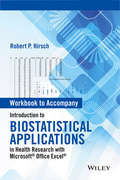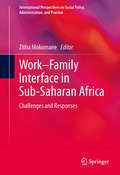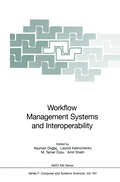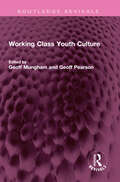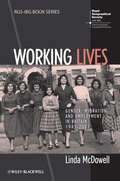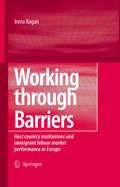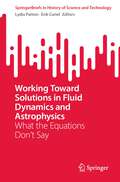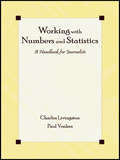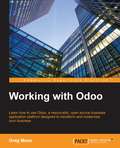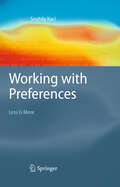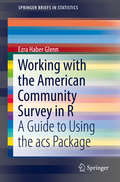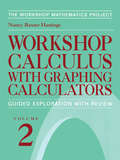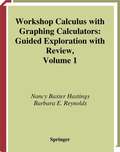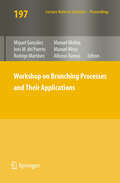- Table View
- List View
Workbook to Accompany Introduction to Biostatistical Applications in Health Research with Microsoft Office Excel
by Robert P. HirschWorkbook to accompany Introduction to Biostatistical Applications in Health Research with Microsoft Office Excel—practical and methodological approach to the statistical logic of biostatistics in the field of health research.
A Worked Problem Approach: Introductory Finance 361. A custom for University of Nebraska - Lincoln
by John GeppertThis book is intended to be your first introduction to the TOOLS of finance. It is not a survey of finance, but rather a collection of the foundational tools you can ACTUALLY USE to solve finance problems you will encounter in your personal life and careers. It is intended to be used in the first finance course for finance majors and as a finance founda-tion course for all business majors. The resources contained within are designed to teach you the material and provide you with a reference you can refer back to as you progress to higher level finance courses, or as a targeted refresher.
Work–Family Interface in Sub-Saharan Africa: Challenges and Responses (International Perspectives on Social Policy, Administration, and Practice)
by Zitha MokomaneProblems associated with work-family conflict do not belong to individual families alone, but have a major social and economic impact on the greater community. This scenario also holds true across sub-Saharan Africa, as nations enter the global economy and rising numbers of women enter the workforce.One of the first resources to focus on this region, Work-Family Interface in Sub-Saharan Africa probes rarely-studied dimensions of conflict between paid employment and family responsibilities. It balances theoretical background, empirical findings and current and emerging interventions for an insightful and practical review of ongoing issues affecting working women with families. Coverage contrasts concepts of work and family between the developing world and the West and related social concerns such as gender expectations and sexual harassment are examined in the work context. The book describes a range of family strategies for resolving work-family friction and chapters end with policy recommendations as first steps toward remedying longstanding challenges. Among the thought-provoking dispatches:Ghana: Managing work and family demandsNigeria: Strain-based family interference with workBotswana: The social impact of job transfer policy on dual-career familiesKenya: The role of household help in work-family balanceSouth Africa: State measures toward work-care integrationZambia: The quest for a family policyAs evinced by these chapters, progress is gradual and far from uniform. As a guide for future study and future policy, Work-Family Interface in Sub-Saharan Africa is a substantial reference for sociologists, public health professionals, public and social policymakers and administrators.
Workflow Management Systems and Interoperability (NATO ASI Subseries F: #164)
by Asuman Dogac Leonid Kalinichenko Tamer Özsu Amit ShethWorkflow management systems (WFMS) are enjoying increasing popular ity due to their ability to coordinate and streamline complex organizational processes within organizations of all sizes. Organizational processes are de scriptions of an organization's activities engineered to fulfill its mission such as completing a business contract or satisfying a specific customer request. Gaining control of these processes allows an organization to reengineer and improve each process or adapt them to changing requirements. The goal of WFMSs is to manage these organizational processes and coordinate their execution. was demonstrated in the first half The high degree of interest in WFMSs of the 1990s by a significant increase in the number of commercial products (once estimated to about 250) and the estimated market size (in combined $2 billion in 1996. Ensuing maturity product sales and services) of about is demonstrated by consolidations during the last year. Ranging from mere e-mail based calendar tools and flow charting tools to very sophisticated inte grated development environments for distributed enterprise-wide applications and systems to support programming in the large, these products are finding an eager market and opening up important research and development op portunities. In spite of their early success in the market place, however, the current generation of systems can benefit from further research and develop ment, especially for increasingly complex and mission-critical applications.
Working Beyond 60: Key Policies and Practices in Europe
by G. Reday-MulveyWhile the question to why work beyond sixty has now become obvious, the how and for whom questions are the real topic of this new study by one of the best European specialists in the area. Work after sixty - if it is to be feasible and widespread - has to be on a part-time basis to meet the wishes and needs of workers and companies. This book provides an in-depth analysis of the growing importance of work beyond sixty and a comparative discussion of new policies in several EU Member States as well as of company practice.
Working Class Youth Culture (Routledge Revivals)
by Geoff Mungham Geoff PearsonFirst published in 1976, Working Class Youth Culture offers a much-needed alternative viewpoint to the law-and-order lobby which treats the youth question as a dreadful pest to be exterminated or caged in. The contributors describe the real conditions of life for working-class youth; how they make sense of the world; and how we can understand their perspective. The subjects discussed include Teddy Boys, Mods, Skinheads and the Glamrock Cult; dance-hall fights; picking up girls and going steady; how schools manufacture delinquency, truancy and vandalism; how working-class kids slide from bad schools to bad jobs, or to no jobs at all; Paki-bashing, racism and the competition over jobs and houses; how social change in post-war Britain has influenced youth culture; and how social scientists have hidden the real character of youth troubles behind the myth of a classless society. This book will be of interest to students of sociology and anthropology.
Working Class Youth Culture (Routledge Revivals)
First published in 1976, Working Class Youth Culture offers a much-needed alternative viewpoint to the law-and-order lobby which treats the youth question as a dreadful pest to be exterminated or caged in. The contributors describe the real conditions of life for working-class youth; how they make sense of the world; and how we can understand their perspective. The subjects discussed include Teddy Boys, Mods, Skinheads and the Glamrock Cult; dance-hall fights; picking up girls and going steady; how schools manufacture delinquency, truancy and vandalism; how working-class kids slide from bad schools to bad jobs, or to no jobs at all; Paki-bashing, racism and the competition over jobs and houses; how social change in post-war Britain has influenced youth culture; and how social scientists have hidden the real character of youth troubles behind the myth of a classless society. This book will be of interest to students of sociology and anthropology.
Working for Yourself Without Capital
by B.H. ElvyMost of the schemes to assist the unemployed to set-up in business for themselves require applicants to contribute towards the start-up capital. Yet many people thrown out of work by the recession are not in a position to do so. This book explores a number of business options that can be started with minimal outlay. It also explains how to control the money side, find customers and organise oneself to earn money by using one's personal skills, knowledge and experience.
Working Lives: Gender, Migration and Employment in Britain, 1945-2007 (RGS-IBG Book Series)
by Linda McDowellFull of unique and compelling insights into the working lives of migrant women in the UK, this book draws on more than two decades of in-depth research to explore the changing nature of women’s employment in post-war Britain. A first-rate example of theoretically located empirical analysis of labour market change in contemporary Britain Includes compelling case studies that combine historical documentation of social change with fascinating first-hand accounts of women’s working lives over decades Integrates information gleaned from more than two decades of in-depth research Revealing comparative analysis of the similarities and differences in the lives of immigrant working women in post-war Britain Features real-life accounts of women’s under-reported experiences of migration
Working Lives: Gender, Migration and Employment in Britain, 1945-2007 (RGS-IBG Book Series)
by Linda McDowellFull of unique and compelling insights into the working lives of migrant women in the UK, this book draws on more than two decades of in-depth research to explore the changing nature of women’s employment in post-war Britain. A first-rate example of theoretically located empirical analysis of labour market change in contemporary Britain Includes compelling case studies that combine historical documentation of social change with fascinating first-hand accounts of women’s working lives over decades Integrates information gleaned from more than two decades of in-depth research Revealing comparative analysis of the similarities and differences in the lives of immigrant working women in post-war Britain Features real-life accounts of women’s under-reported experiences of migration
Working Through Barriers: Host Country Institutions and Immigrant Labour Market Performance in Europe
by Irena KoganThis book examines the role that institutional characteristics of host countries play in labour market integration of immigrants in the European Union. Drawing on existing research, it develops a comprehensive conceptual framework of factors and underlying mechanisms which affect immigrant integration in the fifteen nations that comprise the European Union. The author analyzes selected EU countries in depth, investigating the extent to which immigrants have succeeded or failed in different institutional contexts.
Working Toward Solutions in Fluid Dynamics and Astrophysics: What the Equations Don’t Say (SpringerBriefs in History of Science and Technology)
by Lydia Patton Erik CurielThis book focuses on continuing the long-standing productive dialogue between physical science and the philosophy of science. Researchers and readers who want to keep up to date on front-line scientific research in fluid mechanics and gravitational wave astrophysics will find timely and well-informed analyses of this scientific research and its philosophical significance. These exciting frontiers of research pose deep scientific problems, and raise key questions in the philosophy of science related to scientific explanation and understanding, theory change and assessment, measurement, interpretation, realism, and modeling. The audience of the book includes philosophers of science, philosophers of mathematics, scientists with philosophical interests, and students in philosophy, history, mathematics, and science. Anyone who is interested in the methods and philosophical questions behind the recent exciting work in physics discussed here will profit from reading this book.
Working With Diagrams (Studies in Social Analysis #14)
by Lukas Engelmann, Caroline Humphrey Christos LynterisArising from the need to go beyond the semiotic, cognitive, epistemic and symbolic reading of diagrams, this book looks at what diagrams are capable of in scholarly work related to the social sciences. Rather than attempting to define what diagrams are, and what their dietic capacity might be, contributions to this volume draw together the work diagrams do in the development of theories. Across a range of disciplines, the chapters introduce the ephemeral dimensions of scientist’s interactions and collaboration with diagrams, consider how diagrams configure cooperation across disciplines, and explore how diagrams have been made to work in ways that point beyond simplification, clarification and formalization.
Working with Dynamical Systems: A Toolbox for Scientists and Engineers (Series in Computational Biophysics)
by Len PismenThis book provides working tools for the study and design of nonlinear dynamical systems applicable in physics and engineering. It offers a broad-based introduction to this challenging area of study, taking an applications-oriented approach that emphasizes qualitative analysis and approximations rather than formal mathematics or simulation. The author, an internationally recognized authority in the field, makes extensive use of examples and includes executable Mathematica notebooks that may be used to generate new examples as hands-on exercises. The coverage includes discussion of mechanical models, chemical and ecological interactions, nonlinear oscillations and chaos, forcing and synchronization, spatial patterns and waves. Key Features: · Written for a broad audience, avoiding dependence on mathematical formulations in favor of qualitative, constructive treatment. · Extensive use of physical and engineering applications. · Incorporates Mathematica notebooks for simulations and hands-on self-study. · Provides a gentle but rigorous introduction to real-world nonlinear problems. · Features a final chapter dedicated to applications of dynamical systems to spatial patterns. The book is aimed at student and researchers in applied mathematics and mathematical modelling of physical and engineering problems. It teaches to see common features in systems of different origins, and to apply common methods of study without losing sight of complications and uncertainties related to their physical origin.
Working with Dynamical Systems: A Toolbox for Scientists and Engineers (Series in Computational Biophysics)
by Len PismenThis book provides working tools for the study and design of nonlinear dynamical systems applicable in physics and engineering. It offers a broad-based introduction to this challenging area of study, taking an applications-oriented approach that emphasizes qualitative analysis and approximations rather than formal mathematics or simulation. The author, an internationally recognized authority in the field, makes extensive use of examples and includes executable Mathematica notebooks that may be used to generate new examples as hands-on exercises. The coverage includes discussion of mechanical models, chemical and ecological interactions, nonlinear oscillations and chaos, forcing and synchronization, spatial patterns and waves. Key Features: · Written for a broad audience, avoiding dependence on mathematical formulations in favor of qualitative, constructive treatment. · Extensive use of physical and engineering applications. · Incorporates Mathematica notebooks for simulations and hands-on self-study. · Provides a gentle but rigorous introduction to real-world nonlinear problems. · Features a final chapter dedicated to applications of dynamical systems to spatial patterns. The book is aimed at student and researchers in applied mathematics and mathematical modelling of physical and engineering problems. It teaches to see common features in systems of different origins, and to apply common methods of study without losing sight of complications and uncertainties related to their physical origin.
Working with Legacy Systems: A Practical Guide To Looking After And Maintaining The Systems We Inherit
by Robert AnnettA practical guide to looking after and maintaining the systems we inherit
Working With Numbers and Statistics: A Handbook for Journalists
by Charles Livingston Paul S. VoakesWorking With Numbers and Statistics: A Handbook for Journalists will bolster math skills and improve math confidence for journalists at all skill levels. Authors Charles Livingston and Paul Voakes developed this resource book to improve journalistic writing and reporting, enabling journalists to:*make accurate, reliable computations, which in turn enables one to make relevant comparisons, put facts into perspective, and lend important context to stories;*recognize inaccurate presentations, whether willfully spun or just carelessly relayed;*ask appropriate questions about numerical matters;*translate complicated numbers for viewers and readers in ways they can readily understand;*understand computer-assisted reporting; and*write livelier, more precise pieces through the use of numbers.The math is presented in a journalistic context throughout, enabling readers to see how the procedures will come into play in their work.Working With Numbers and Statistics is designed as a reference work for journalism students developing their writing and reporting skills. It will also serve professionals as a useful tool to improve their understanding and use of numbers in news stories.
Working With Numbers and Statistics: A Handbook for Journalists
by Charles Livingston Paul S. VoakesWorking With Numbers and Statistics: A Handbook for Journalists will bolster math skills and improve math confidence for journalists at all skill levels. Authors Charles Livingston and Paul Voakes developed this resource book to improve journalistic writing and reporting, enabling journalists to:*make accurate, reliable computations, which in turn enables one to make relevant comparisons, put facts into perspective, and lend important context to stories;*recognize inaccurate presentations, whether willfully spun or just carelessly relayed;*ask appropriate questions about numerical matters;*translate complicated numbers for viewers and readers in ways they can readily understand;*understand computer-assisted reporting; and*write livelier, more precise pieces through the use of numbers.The math is presented in a journalistic context throughout, enabling readers to see how the procedures will come into play in their work.Working With Numbers and Statistics is designed as a reference work for journalism students developing their writing and reporting skills. It will also serve professionals as a useful tool to improve their understanding and use of numbers in news stories.
Working with Odoo
by Greg MossLearn how to use Odoo, a resourceful, open source business application platform designed to transform and modernize your business About This Book • Configure, manage, and customize Odoo to fit the needs of your business • Learn about the new Odoo 8 website builder and e-commerce features that are seamlessly integrated with Odoo's business applications • Perform step-by-step configurations of the most important Odoo applications using real-world examples Who This Book Is For This book is perfect for people who have never used Odoo and for those who would like to learn about more advanced features such as creating your own custom modules. In order to get the most out of this book, you should be comfortable with downloading and installing software and understand basic business concepts such as sales, purchasing, inventory management, and basic accounting. What You Will Learn • Configure a functioning customer relationship management system • Set up a purchasing and receiving system for your company that allows you to track inventory, costs, and profit • Implement manufacturing operations and processes using real-world examples that you can put to use in your own company • Discover the capabilities of Odoo's financial accounting and reporting features • Integrate powerful human resource applications that simplify the collection and management of employee information • Utilize Odoo's full featured project management application to organize tasks and track time and costs associated with billable projects • Customize Odoo without writing a line a code In Detail Odoo continues to gain momentum throughout the world in regards to providing the best platform for open source ERP installations. Now with Odoo 8, you have access to a powerful website builder, integrated e-commerce features, and a fast-growing community to help transform and modernize your business. With this practical guide, you will cover the essential modules to get Odoo up and running for your company. After installing Odoo, you will use its sales management application to enter quotes, create sales orders, and invoice customers. You will then learn how to integrate the CRM application to manage your leads and convert them into lucrative opportunities and sales. Next, you will set up your own purchase management system, assigning products to suppliers and tracking orders with the new warehouse management and routing system. Finally, you will learn how to use analytics to track project expenses and keep your accounts simple and easy to maintain and build an Odoo module to extend its functionality and make it work for you. Working with Odoo covers all the core installation and usage functionalities of this popular tool, helping you to fully implement a working ERP system through practical, advanced, real-world examples. Style and approach This book is a practical guide that uses real-world examples to teach you how to implement Odoo into your business.
Working with Preferences: Less Is More (Cognitive Technologies)
by Souhila KaciPreferences are useful in many real-life problems, guiding human decision making from early childhood up to complex professional and organizational decisions. In artificial intelligence specifically, preferences is a relatively new topic of relevance to nonmonotonic reasoning, multiagent systems, constraint satisfaction, decision making, social choice theory and decision-theoretic planning The first part of this book deals with preference representation, with specific chapters dedicated to representation languages, nonmonotonic logics of preferences, conditional preference networks, positive and negative preferences, and the study of preferences in cognitive psychology. The second part of the book deals with reasoning with preferences, and includes chapters dedicated to preference-based argumentation, preferences database queries, and rank-ordering outcomes and intervals. The author concludes by examining forthcoming research perspectives. This is inherently a multidisciplinary topic and this book will be of interest to computer scientists, economists, operations researchers, mathematicians, logicians, philosophers and psychologists.
Working with the American Community Survey in R: A Guide to Using the acs Package (SpringerBriefs in Statistics)
by Ezra Haber GlennThis book serves as a hands-on guide to the "acs" R package for demographers, planners, and other researchers who work with American Community Survey (ACS) data. It gathers the most common problems associated with using ACS data and implements functions as a package in the R statistical programming language. The package defines a new "acs" class object (containing estimates, standard errors, and metadata for tables from the ACS) with methods to deal appropriately with common tasks (e.g., creating and combining subgroups or geographies, automatic fetching of data via the Census API, mathematical operations on estimates, tests of significance, plots of confidence intervals).
Workshop Calculus with Graphing Calculators: Guided Exploration with Review (Textbooks in Mathematical Sciences)
by Nancy Baxter HastingsBased on the use of graphing calculators by students enrolled in calculus, there is enough material here to cover precalculus review, as well as first-year single variable calculus topics. Intended for use in workshop-centered calculus courses, and developed as part of the well-known NSF-sponsored project, the text is for use with students in a math laboratory, instead of a traditional lecture course. There are student-oriented activities, experiments and graphing calculator exercises throughout the text. The authors themselves are well-known teachers and constantly striving to improve undergraduate mathematics teaching.
Workshop Calculus with Graphing Calculators: Guided Exploration with Review (Textbooks in Mathematical Sciences)
by Nancy Baxter Hastings Barbara E. ReynoldsBased on the popular "Workshop Approach", which has been hailed by the community for its hands on approach, these new versions of the popular Workshop Calculus allow the easy incorporation of a graphing calculator. Like the originals, these volumes cover topics in calculus while simultaneously reviewing precalculus concepts. Activities, experiments, and exercises are found throughout.
Workshop on Branching Processes and Their Applications (Lecture Notes in Statistics #197)
by Miguel González Inés M. Puerto Rodrigo Martínez Manuel Molina Manuel Mota Alfonso RamosOne of the charms of mathematics is the contrast between its generality and its applicability to concrete, even everyday, problems. Branching processes are typical in this. Their niche of mathematics is the abstract pattern of reproduction, sets of individuals changing size and composition through their members reproducing; in other words, what Plato might have called the pure idea behind demography, population biology, cell kinetics, molecular replication, or nuclear ?ssion, had he known these scienti?c ?elds. Even in the performance of algorithms for sorting and classi?cation there is an inkling of the same pattern. In special cases, general properties of the abstract ideal then interact with the physical or biological or whatever properties at hand. But the population, or bran- ing, pattern is strong; it tends to dominate, and here lies the reason for the extreme usefulness of branching processes in diverse applications. Branching is a clean and beautiful mathematical pattern, with an intellectually challenging intrinsic structure, and it pervades the phenomena it underlies.
